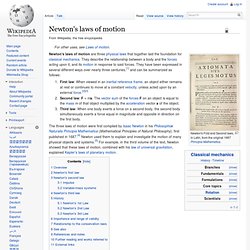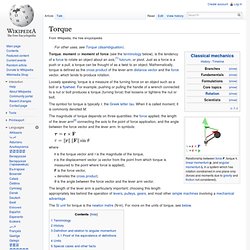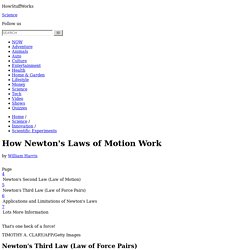

Newton's laws of motion. First law: When viewed in an inertial reference frame, an object either remains at rest or continues to move at a constant velocity, unless acted upon by an external force.[2][3]Second law: F = ma.

The vector sum of the forces F on an object is equal to the mass m of that object multiplied by the acceleration vector a of the object.Third law: When one body exerts a force on a second body, the second body simultaneously exerts a force equal in magnitude and opposite in direction on the first body. The three laws of motion were first compiled by Isaac Newton in his Philosophiæ Naturalis Principia Mathematica (Mathematical Principles of Natural Philosophy), first published in 1687.[4] Newton used them to explain and investigate the motion of many physical objects and systems.[5] For example, in the third volume of the text, Newton showed that these laws of motion, combined with his law of universal gravitation, explained Kepler's laws of planetary motion.
Overview. Science help plz quick 10 points best answer. Newton's Laws. Torque. Torque, moment or moment of force (see the terminology below), is the tendency of a force to rotate an object about an axis,[1] fulcrum, or pivot.

Just as a force is a push or a pull, a torque can be thought of as a twist to an object. Mathematically, torque is defined as the cross product of the lever-arm distance vector and the force vector, which tends to produce rotation. Loosely speaking, torque is a measure of the turning force on an object such as a bolt or a flywheel. For example, pushing or pulling the handle of a wrench connected to a nut or bolt produces a torque (turning force) that loosens or tightens the nut or bolt.
The symbol for torque is typically τ, the Greek letter tau. The magnitude of torque depends on three quantities: the force applied, the length of the lever arm[2] connecting the axis to the point of force application, and the angle between the force vector and the lever arm. Where. Newton's Third Law (Law of Force Pairs)" Newton's third law is probably the most familiar.

Everyone knows that every action has an equal and opposite reaction, right? Unfortunately, this statement lacks some necessary detail. This is a better way to say it: A force is exerted by one object on another object. In other words, every force involves the interaction of two objects. Many people have trouble visualizing this law because it's not as intuitive. Clearly, the swimmer is applying a force to the wall, but her motion indicates that a force is being applied to her, too. Next, think about a book lying on a table. If you're catching on to Newton's third law, you should have noticed another force pair described in the paragraph above. You see something similar, although on a much smaller scale, when a baseball bat strikes a ball.
These examples don't show a practical application of Newton's third law. Speaking of outer space, Newton's other laws apply there, too. Newton's Three Laws of Motion. Newton's Three Lawsof Motion Let us begin our explanation of how Newton changed our understanding of the Universe by enumerating his Three Laws of Motion.

Newton's First Law of Motion: Newton's Second Law of Motion: This is the most powerful of Newton's three Laws, because it allows quantitative calculations of dynamics: how do velocities change when forces are applied. Notice the fundamental difference between Newton's 2nd Law and the dynamics of Aristotle: according to Newton, a force causes only a change in velocity (an acceleration); it does not maintain the velocity as Aristotle held.
Newton's Third Law of Motion: This law is exemplified by what happens if we step off a boat onto the bank of a lake: as we move in the direction of the shore, the boat tends to move in the opposite direction (leaving us facedown in the water, if we aren't careful!).